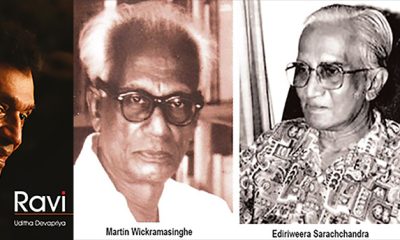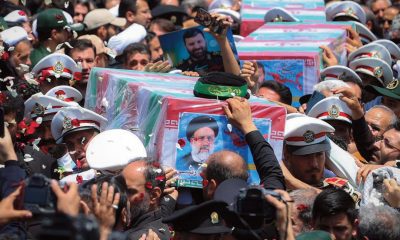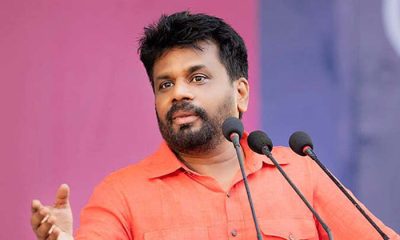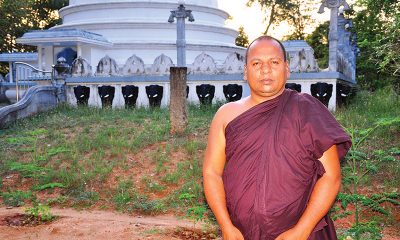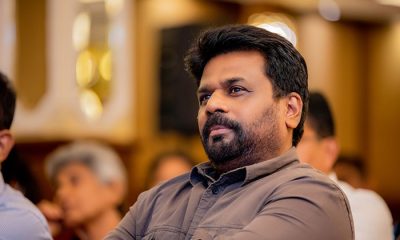Features
Finding the Rural in the Urban
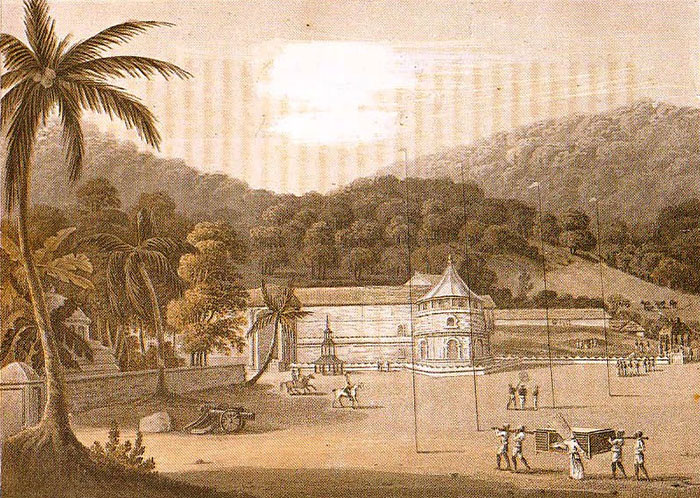
By Uditha Devapriya
Over the last two years I have been travelling to various parts of the country, trying to make sense of how rural communities operate, how they think and how they see the world. In all my travels I have come to realise how much rural beliefs and practices influence the most urban milieus in Sri Lanka. Dhanuka Bandara’s excellent essay on Gota Go Gama, published earlier this year, sheds light on this by charting the rural-utopian origins of the aragalaya, an ostensibly “urban” phenomenon. He ends his essay thus.
It is the essential anarchism of the “village” as a political category that fuelled the aragalaya and was able to bring together many competing factions to achieve a singular end that most people in Sri Lanka desired. Although the aragalaya ended anti-climactically, with Ranil Wickremesinghe coming to power and continuing the rule of the same old establishment, its real achievements should not be dismissed. Nor should anyone dismiss agrarian utopianism as a naive nationalist fantasy, as it could be the blueprint for a cosmopolitan future.
There is nothing naïve about nationalism, or about rural utopianism. This is particularly so because in Sri Lanka, the rural is present everywhere; it exerts itself over the urban in so many ways. I call this the ruralisation of the urban. Anthropologists and social scientists, for some reason, concern themselves with the obverse of this process, the urbanisation of the rural. Even Martin Wickramasinghe, who charted more presciently than did any other author the decay of the Sinhala village, focused on upheaval in the village and saw its decay as an axiom of the historical process, likening efforts to revive the past to a search for kalunika. In our focus on “changes in the village” – the gam-peraliya – we thus overlook what survives in the rural, and what gets transferred to the urban or suburban.
Those who had been to the aragalaya last year, for instance, would have noticed how quickly the rural elements swept over Gotagogama, how much their fears, anxieties, and frustrations dominated anti-regime discourses there. For these communities the aragalaya served a specific function, as an outlet to vent out their anger, not against an authoritarian quasi-dictator – Colombo society’s favourite depiction of Gotabaya Rajapaksa – but rather an incompetent administrator, a man who had failed to deliver.
There was a somewhat palpable though barely felt city-rural rift in the aragalaya. On his way to Gota Go Gama, a friend of mine shared a trishaw ride with a farmer who had travelled all the way from Nuwara-Eliya. What surprised my friend was that he had come to Colombo despite the fuel shortages, to express his anger against the government, a government he had voted for. “There is nothing more to hope or live for,” he had told my friend. “I want to be here, to join others let down by this man Gotabaya.” This had stymied my friend: “Until then I was unaware that such people existed.” I could not tell what surprised me more: the old man’s iron-clad determination to join the aragalaya, or the young aragalista’s ignorance, until then, of such communities and milieus.
The aragalaya brought these elements together, at least momentarily. The bourgeois elements did not mind being dominated by or dictated to by farmers and angry university students in a campaign they had patronised and sponsored. Yet what solidarity there was between these groups ended in a stalemate, if not anticlimax: the election of the Colombo upper classes’ favourite political figurehead as president. Should we frame this as a triumph of the urban over the rural, of urban “liberal” discourses of dissent over rural (though no means illiberal) discourses of rebellion? Such a reading would be simplistic, because it fails to account for the incredible diversity of the aragalaya. Yet it behoves us to reconsider and reframe the relationship between city and village in here.
We hold the most romantic and utopian notions of the village: our preferred prototypes are Anuradhapura and Kandy. As Bandara argues in his essay, such readings of the Sri Lankan – or Sinhala – village were reinforced by the most cosmopolitan people, including S. W. R. D. Bandaranaike. One notices in the writings of such people an urge to preserve the innocence of the village, to shield it from the corruption of the city.
In colonial Sri Lanka, the urge to preserve the village was expressed in different ways. Often it concealed insidious motives. In the late 19th century, Sinhalese elites and British officials alike deplored the tendency of villagers to educate their children in English. Oriental scholars like James de Alwis, educated in English schools but was taught Sinhalese and Pali by Buddhist monks, called for a shift to vernacular education. The comprador elite reiterated these calls; they probably resented their children sharing classrooms with village ilk.
What is so fascinating about this is that the colonial government had spent the better part of twenty or so years ceding education to Christian missions, weaning locals away from traditional “rural” customs and turning them into mock Englishmen. In doing so they overlooked the impact this would have on the rural-agrarian foundations of Sri Lankan society. In their rush to educate their children in English, the peasantry racked up debts which they later found they could not repay. Thus, from Colebrooke-Cameron’s emphasis on English education the government began opening Sinhala and Tamil schools. The class bias here was hard to miss: Sinhala and Tamil schools catered to the many, but were of an elementary nature, while the English schools, which catered to the few, were elite and superior.
Despite certain differences, the parallels between this and the aragalaya should be evident to all. In the aragalaya, too, the rural spread itself over the urban, to the extent of co-opting and dominating urban values, their worldview, their way of being. The homophobic insults I heard over the loudspeakers on July 12 were hardly to the liking of the Colombo liberal establishment, but they were eagerly consumed and reiterated by the protestors.
Yet the minute it reached saturation point, the urban elements opposed the domination of these elements and sought to reinforce their hegemony. As with English education in 19th century Ceylon, so with a mass uprising against an unpopular regime in the present century. In both cases, the bourgeoisie regained their hold, despite or more likely because of the penetration of rural elements in an eminently upper middle-class affair.
The difference between then and now is that while there were no safeguards against the hegemonical tendencies of the elite in the 19th century, there are now enough and more mechanisms to ensure a more equitable, representative social order.
What I mean here is that the right to vote and access to public facilities – in particular, free education – have liberated the rural underclass and middle-class and empowered it to take hold of the public imagination. The pushback against IMF reforms by these elements shows that despite the Colombo thinktankocracy’s missives about the necessity of such reforms, they will be resisted by those who suffer from them. Though Colombo society depicted the march to parliament on July 13 as a Leftist ploy, the prospect of such a putsch has a wide romantic appeal. Hence Anura Kumara Dissanayake’s recent intervention in The Hindu: what we need, he says, is not regime change, but national liberation.
The colonial State could prevent the permeation of the rural in the urban because it was in its interest and within its powers to do so. To allow such permeation would have diluted the hegemony of the elite, thus threatening the basis of colonial rule. The bourgeois State, by contrast, can stall this only at the risk of inciting insurrection or insurgency, as the Sri Lankan government found out at an exorbitant cost in 1988 and 2022.
It was the Gotabaya Rajapaksa regime’s disastrous fertiliser policies that alienated its single biggest electorate, the Sinhala peasantry. Though fuel shortages and power cuts affected the middle-classes, they devasted rural communities as well. These elements joined hands at the aragalaya, summoning the spectre of rural discontent. The bourgeois elements struck at them after a while, but their hold on the popular imagination has stayed.
In almost every way, then, the urban in Sri Lanka continues to be shaped – one could say determined – by the rural. Despite its best efforts, the colonial State could not prevent the penetration of the one into the other. The introduction of the vote, and of free education, has completed the circle. The changing village that Martin Wickramasinghe saw, and charted so impressively, is no longer restricted to the village: it is also in the city.
Free education, in particular, has opened a window to the rural middle-classes – the rural petty bourgeoisie – to enter the most elite enclaves and make their mark on institutions that were once zealously guarded by the English-speaking hoi-polloi. To paraphrase that student who debated the merits of secularism with me, these institutions are no longer the preserve of the elite, but of the best: the best in the country, emigres from the village. This is as true of Royal College, Peradeniya University, and Lake House – the triad of the Sri Lankan colonial elite, as Dayan Jayatilleka once observed – as it is of the aragalaya.
The writer is an international relations analyst, independent researcher, and freelance columnist who can be reached at udakdev1@gmail.com.
Features
The heart-friendly health minister

by Dr Gotabhya Ranasinghe
Senior Consultant Cardiologist
National Hospital Sri Lanka
When we sought a meeting with Hon Dr. Ramesh Pathirana, Minister of Health, he graciously cleared his busy schedule to accommodate us. Renowned for his attentive listening and deep understanding, Minister Pathirana is dedicated to advancing the health sector. His openness and transparency exemplify the qualities of an exemplary politician and minister.
Dr. Palitha Mahipala, the current Health Secretary, demonstrates both commendable enthusiasm and unwavering support. This combination of attributes makes him a highly compatible colleague for the esteemed Minister of Health.
Our discussion centered on a project that has been in the works for the past 30 years, one that no other minister had managed to advance.
Minister Pathirana, however, recognized the project’s significance and its potential to revolutionize care for heart patients.
The project involves the construction of a state-of-the-art facility at the premises of the National Hospital Colombo. The project’s location within the premises of the National Hospital underscores its importance and relevance to the healthcare infrastructure of the nation.
This facility will include a cardiology building and a tertiary care center, equipped with the latest technology to handle and treat all types of heart-related conditions and surgeries.
Securing funding was a major milestone for this initiative. Minister Pathirana successfully obtained approval for a $40 billion loan from the Asian Development Bank. With the funding in place, the foundation stone is scheduled to be laid in September this year, and construction will begin in January 2025.
This project guarantees a consistent and uninterrupted supply of stents and related medications for heart patients. As a result, patients will have timely access to essential medical supplies during their treatment and recovery. By securing these critical resources, the project aims to enhance patient outcomes, minimize treatment delays, and maintain the highest standards of cardiac care.
Upon its fruition, this monumental building will serve as a beacon of hope and healing, symbolizing the unwavering dedication to improving patient outcomes and fostering a healthier society.We anticipate a future marked by significant progress and positive outcomes in Sri Lanka’s cardiovascular treatment landscape within the foreseeable timeframe.
Features
A LOVING TRIBUTE TO JESUIT FR. ALOYSIUS PIERIS ON HIS 90th BIRTHDAY

by Fr. Emmanuel Fernando, OMI
Jesuit Fr. Aloysius Pieris (affectionately called Fr. Aloy) celebrated his 90th birthday on April 9, 2024 and I, as the editor of our Oblate Journal, THE MISSIONARY OBLATE had gone to press by that time. Immediately I decided to publish an article, appreciating the untiring selfless services he continues to offer for inter-Faith dialogue, the renewal of the Catholic Church, his concern for the poor and the suffering Sri Lankan masses and to me, the present writer.
It was in 1988, when I was appointed Director of the Oblate Scholastics at Ampitiya by the then Oblate Provincial Fr. Anselm Silva, that I came to know Fr. Aloy more closely. Knowing well his expertise in matters spiritual, theological, Indological and pastoral, and with the collaborative spirit of my companion-formators, our Oblate Scholastics were sent to Tulana, the Research and Encounter Centre, Kelaniya, of which he is the Founder-Director, for ‘exposure-programmes’ on matters spiritual, biblical, theological and pastoral. Some of these dimensions according to my view and that of my companion-formators, were not available at the National Seminary, Ampitiya.
Ever since that time, our Oblate formators/ accompaniers at the Oblate Scholasticate, Ampitiya , have continued to send our Oblate Scholastics to Tulana Centre for deepening their insights and convictions regarding matters needed to serve the people in today’s context. Fr. Aloy also had tried very enthusiastically with the Oblate team headed by Frs. Oswald Firth and Clement Waidyasekara to begin a Theologate, directed by the Religious Congregations in Sri Lanka, for the contextual formation/ accompaniment of their members. It should very well be a desired goal of the Leaders / Provincials of the Religious Congregations.
Besides being a formator/accompanier at the Oblate Scholasticate, I was entrusted also with the task of editing and publishing our Oblate journal, ‘The Missionary Oblate’. To maintain the quality of the journal I continue to depend on Fr. Aloy for his thought-provoking and stimulating articles on Biblical Spirituality, Biblical Theology and Ecclesiology. I am very grateful to him for his generous assistance. Of late, his writings on renewal of the Church, initiated by Pope St. John XX111 and continued by Pope Francis through the Synodal path, published in our Oblate journal, enable our readers to focus their attention also on the needed renewal in the Catholic Church in Sri Lanka. Fr. Aloy appreciated very much the Synodal path adopted by the Jesuit Pope Francis for the renewal of the Church, rooted very much on prayerful discernment. In my Religious and presbyteral life, Fr.Aloy continues to be my spiritual animator / guide and ongoing formator / acccompanier.
Fr. Aloysius Pieris, BA Hons (Lond), LPh (SHC, India), STL (PFT, Naples), PhD (SLU/VC), ThD (Tilburg), D.Ltt (KU), has been one of the eminent Asian theologians well recognized internationally and one who has lectured and held visiting chairs in many universities both in the West and in the East. Many members of Religious Congregations from Asian countries have benefited from his lectures and guidance in the East Asian Pastoral Institute (EAPI) in Manila, Philippines. He had been a Theologian consulted by the Federation of Asian Bishops’ Conferences for many years. During his professorship at the Gregorian University in Rome, he was called to be a member of a special group of advisers on other religions consulted by Pope Paul VI.
Fr. Aloy is the author of more than 30 books and well over 500 Research Papers. Some of his books and articles have been translated and published in several countries. Among those books, one can find the following: 1) The Genesis of an Asian Theology of Liberation (An Autobiographical Excursus on the Art of Theologising in Asia, 2) An Asian Theology of Liberation, 3) Providential Timeliness of Vatican 11 (a long-overdue halt to a scandalous millennium, 4) Give Vatican 11 a chance, 5) Leadership in the Church, 6) Relishing our faith in working for justice (Themes for study and discussion), 7) A Message meant mainly, not exclusively for Jesuits (Background information necessary for helping Francis renew the Church), 8) Lent in Lanka (Reflections and Resolutions, 9) Love meets wisdom (A Christian Experience of Buddhism, 10) Fire and Water 11) God’s Reign for God’s poor, 12) Our Unhiddden Agenda (How we Jesuits work, pray and form our men). He is also the Editor of two journals, Vagdevi, Journal of Religious Reflection and Dialogue, New Series.
Fr. Aloy has a BA in Pali and Sanskrit from the University of London and a Ph.D in Buddhist Philosophy from the University of Sri Lankan, Vidyodaya Campus. On Nov. 23, 2019, he was awarded the prestigious honorary Doctorate of Literature (D.Litt) by the Chancellor of the University of Kelaniya, the Most Venerable Welamitiyawe Dharmakirthi Sri Kusala Dhamma Thera.
Fr. Aloy continues to be a promoter of Gospel values and virtues. Justice as a constitutive dimension of love and social concern for the downtrodden masses are very much noted in his life and work. He had very much appreciated the commitment of the late Fr. Joseph (Joe) Fernando, the National Director of the Social and Economic Centre (SEDEC) for the poor.
In Sri Lanka, a few religious Congregations – the Good Shepherd Sisters, the Christian Brothers, the Marist Brothers and the Oblates – have invited him to animate their members especially during their Provincial Congresses, Chapters and International Conferences. The mainline Christian Churches also have sought his advice and followed his seminars. I, for one, regret very much, that the Sri Lankan authorities of the Catholic Church –today’s Hierarchy—- have not sought Fr.
Aloy’s expertise for the renewal of the Catholic Church in Sri Lanka and thus have not benefited from the immense store of wisdom and insight that he can offer to our local Church while the Sri Lankan bishops who governed the Catholic church in the immediate aftermath of the Second Vatican Council (Edmund Fernando OMI, Anthony de Saram, Leo Nanayakkara OSB, Frank Marcus Fernando, Paul Perera,) visited him and consulted him on many matters. Among the Tamil Bishops, Bishop Rayappu Joseph was keeping close contact with him and Bishop J. Deogupillai hosted him and his team visiting him after the horrible Black July massacre of Tamils.
Features
A fairy tale, success or debacle

Sri Lanka-Singapore Free Trade Agreement
By Gomi Senadhira
senadhiragomi@gmail.com
“You might tell fairy tales, but the progress of a country cannot be achieved through such narratives. A country cannot be developed by making false promises. The country moved backward because of the electoral promises made by political parties throughout time. We have witnessed that the ultimate result of this is the country becoming bankrupt. Unfortunately, many segments of the population have not come to realize this yet.” – President Ranil Wickremesinghe, 2024 Budget speech
Any Sri Lankan would agree with the above words of President Wickremesinghe on the false promises our politicians and officials make and the fairy tales they narrate which bankrupted this country. So, to understand this, let’s look at one such fairy tale with lots of false promises; Ranil Wickremesinghe’s greatest achievement in the area of international trade and investment promotion during the Yahapalana period, Sri Lanka-Singapore Free Trade Agreement (SLSFTA).
It is appropriate and timely to do it now as Finance Minister Wickremesinghe has just presented to parliament a bill on the National Policy on Economic Transformation which includes the establishment of an Office for International Trade and the Sri Lanka Institute of Economics and International Trade.
Was SLSFTA a “Cleverly negotiated Free Trade Agreement” as stated by the (former) Minister of Development Strategies and International Trade Malik Samarawickrama during the Parliamentary Debate on the SLSFTA in July 2018, or a colossal blunder covered up with lies, false promises, and fairy tales? After SLSFTA was signed there were a number of fairy tales published on this agreement by the Ministry of Development Strategies and International, Institute of Policy Studies, and others.
However, for this article, I would like to limit my comments to the speech by Minister Samarawickrama during the Parliamentary Debate, and the two most important areas in the agreement which were covered up with lies, fairy tales, and false promises, namely: revenue loss for Sri Lanka and Investment from Singapore. On the other important area, “Waste products dumping” I do not want to comment here as I have written extensively on the issue.
1. The revenue loss
During the Parliamentary Debate in July 2018, Minister Samarawickrama stated “…. let me reiterate that this FTA with Singapore has been very cleverly negotiated by us…. The liberalisation programme under this FTA has been carefully designed to have the least impact on domestic industry and revenue collection. We have included all revenue sensitive items in the negative list of items which will not be subject to removal of tariff. Therefore, 97.8% revenue from Customs duty is protected. Our tariff liberalisation will take place over a period of 12-15 years! In fact, the revenue earned through tariffs on goods imported from Singapore last year was Rs. 35 billion.
The revenue loss for over the next 15 years due to the FTA is only Rs. 733 million– which when annualised, on average, is just Rs. 51 million. That is just 0.14% per year! So anyone who claims the Singapore FTA causes revenue loss to the Government cannot do basic arithmetic! Mr. Speaker, in conclusion, I call on my fellow members of this House – don’t mislead the public with baseless criticism that is not grounded in facts. Don’t look at petty politics and use these issues for your own political survival.”
I was surprised to read the minister’s speech because an article published in January 2018 in “The Straits Times“, based on information released by the Singaporean Negotiators stated, “…. With the FTA, tariff savings for Singapore exports are estimated to hit $10 million annually“.
As the annual tariff savings (that is the revenue loss for Sri Lanka) calculated by the Singaporean Negotiators, Singaporean $ 10 million (Sri Lankan rupees 1,200 million in 2018) was way above the rupees’ 733 million revenue loss for 15 years estimated by the Sri Lankan negotiators, it was clear to any observer that one of the parties to the agreement had not done the basic arithmetic!
Six years later, according to a report published by “The Morning” newspaper, speaking at the Committee on Public Finance (COPF) on 7th May 2024, Mr Samarawickrama’s chief trade negotiator K.J. Weerasinghehad had admitted “…. that forecasted revenue loss for the Government of Sri Lanka through the Singapore FTA is Rs. 450 million in 2023 and Rs. 1.3 billion in 2024.”
If these numbers are correct, as tariff liberalisation under the SLSFTA has just started, we will pass Rs 2 billion very soon. Then, the question is how Sri Lanka’s trade negotiators made such a colossal blunder. Didn’t they do their basic arithmetic? If they didn’t know how to do basic arithmetic they should have at least done their basic readings. For example, the headline of the article published in The Straits Times in January 2018 was “Singapore, Sri Lanka sign FTA, annual savings of $10m expected”.
Anyway, as Sri Lanka’s chief negotiator reiterated at the COPF meeting that “…. since 99% of the tariffs in Singapore have zero rates of duty, Sri Lanka has agreed on 80% tariff liberalisation over a period of 15 years while expecting Singapore investments to address the imbalance in trade,” let’s turn towards investment.
Investment from Singapore
In July 2018, speaking during the Parliamentary Debate on the FTA this is what Minister Malik Samarawickrama stated on investment from Singapore, “Already, thanks to this FTA, in just the past two-and-a-half months since the agreement came into effect we have received a proposal from Singapore for investment amounting to $ 14.8 billion in an oil refinery for export of petroleum products. In addition, we have proposals for a steel manufacturing plant for exports ($ 1 billion investment), flour milling plant ($ 50 million), sugar refinery ($ 200 million). This adds up to more than $ 16.05 billion in the pipeline on these projects alone.
And all of these projects will create thousands of more jobs for our people. In principle approval has already been granted by the BOI and the investors are awaiting the release of land the environmental approvals to commence the project.
I request the Opposition and those with vested interests to change their narrow-minded thinking and join us to develop our country. We must always look at what is best for the whole community, not just the few who may oppose. We owe it to our people to courageously take decisions that will change their lives for the better.”
According to the media report I quoted earlier, speaking at the Committee on Public Finance (COPF) Chief Negotiator Weerasinghe has admitted that Sri Lanka was not happy with overall Singapore investments that have come in the past few years in return for the trade liberalisation under the Singapore-Sri Lanka Free Trade Agreement. He has added that between 2021 and 2023 the total investment from Singapore had been around $162 million!
What happened to those projects worth $16 billion negotiated, thanks to the SLSFTA, in just the two-and-a-half months after the agreement came into effect and approved by the BOI? I do not know about the steel manufacturing plant for exports ($ 1 billion investment), flour milling plant ($ 50 million) and sugar refinery ($ 200 million).
However, story of the multibillion-dollar investment in the Petroleum Refinery unfolded in a manner that would qualify it as the best fairy tale with false promises presented by our politicians and the officials, prior to 2019 elections.
Though many Sri Lankans got to know, through the media which repeatedly highlighted a plethora of issues surrounding the project and the questionable credentials of the Singaporean investor, the construction work on the Mirrijiwela Oil Refinery along with the cement factory began on the24th of March 2019 with a bang and Minister Ranil Wickremesinghe and his ministers along with the foreign and local dignitaries laid the foundation stones.
That was few months before the 2019 Presidential elections. Inaugurating the construction work Prime Minister Ranil Wickremesinghe said the projects will create thousands of job opportunities in the area and surrounding districts.
The oil refinery, which was to be built over 200 acres of land, with the capacity to refine 200,000 barrels of crude oil per day, was to generate US$7 billion of exports and create 1,500 direct and 3,000 indirect jobs. The construction of the refinery was to be completed in 44 months. Four years later, in August 2023 the Cabinet of Ministers approved the proposal presented by President Ranil Wickremesinghe to cancel the agreement with the investors of the refinery as the project has not been implemented! Can they explain to the country how much money was wasted to produce that fairy tale?
It is obvious that the President, ministers, and officials had made huge blunders and had deliberately misled the public and the parliament on the revenue loss and potential investment from SLSFTA with fairy tales and false promises.
As the president himself said, a country cannot be developed by making false promises or with fairy tales and these false promises and fairy tales had bankrupted the country. “Unfortunately, many segments of the population have not come to realize this yet”.
(The writer, a specialist and an activist on trade and development issues . )




